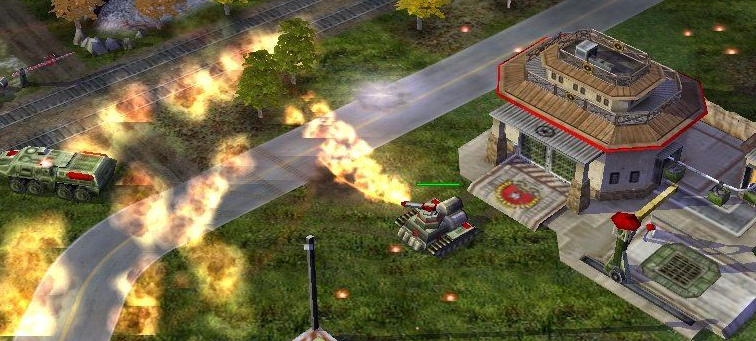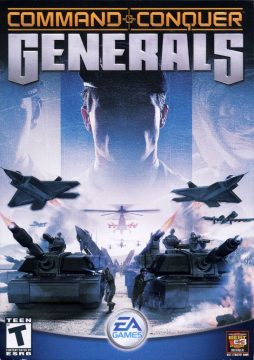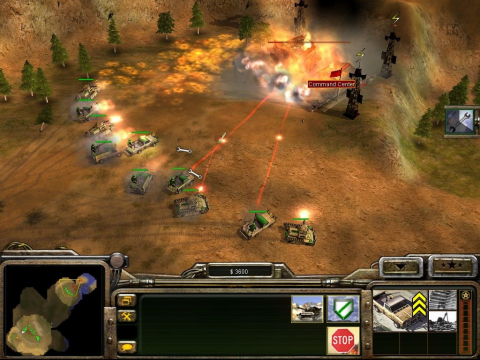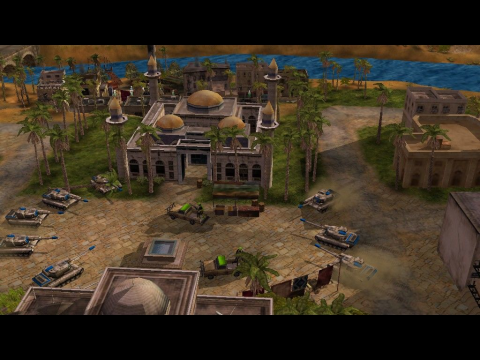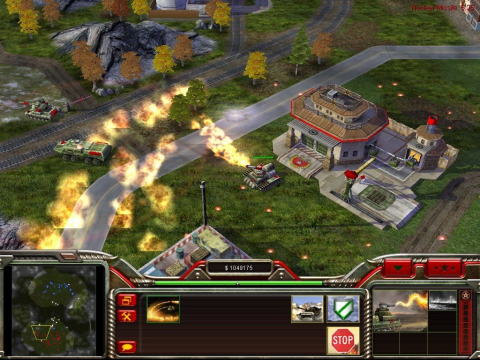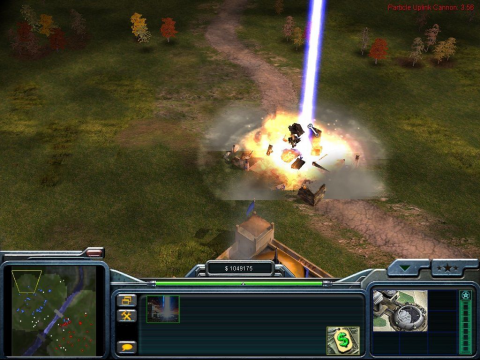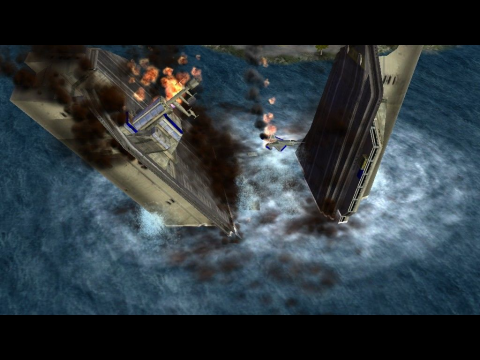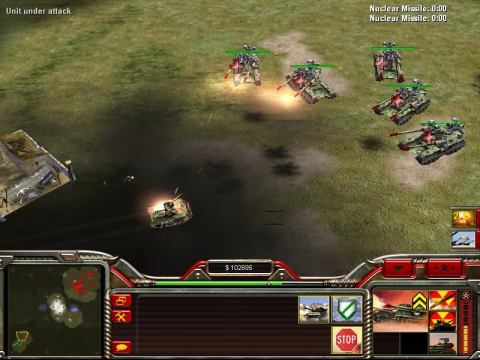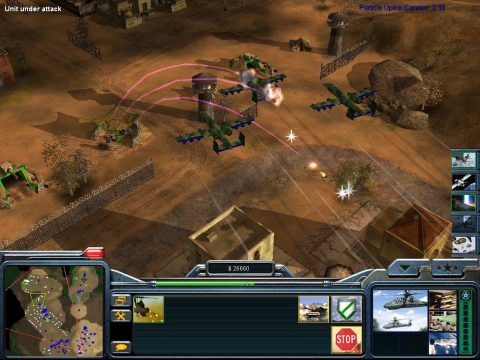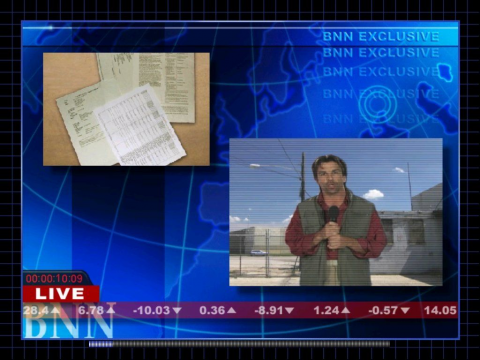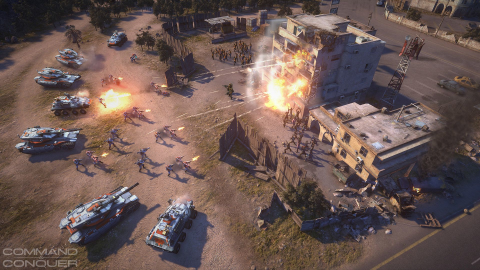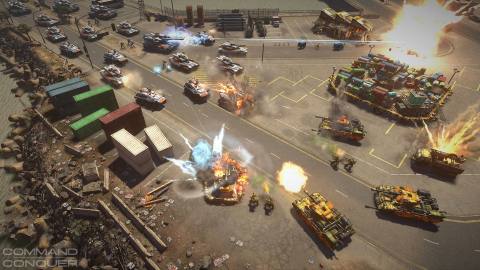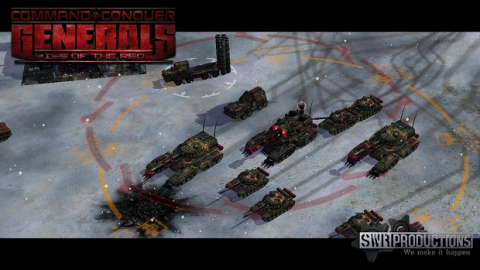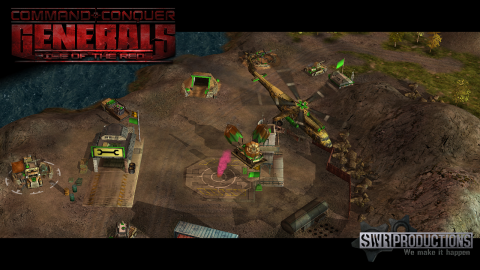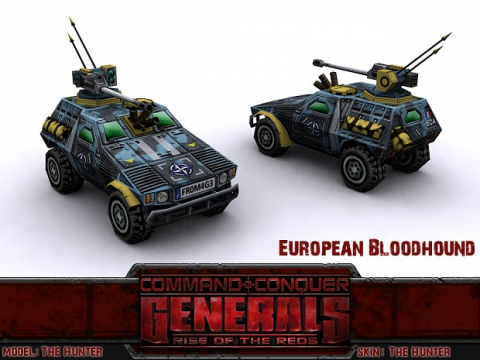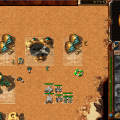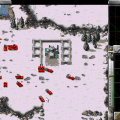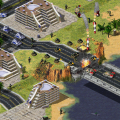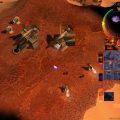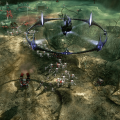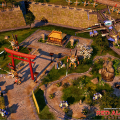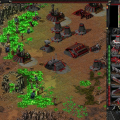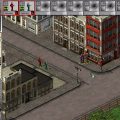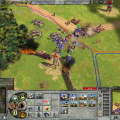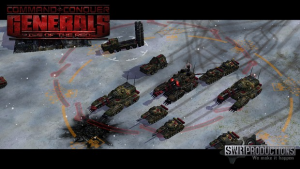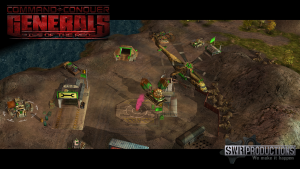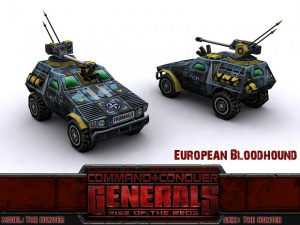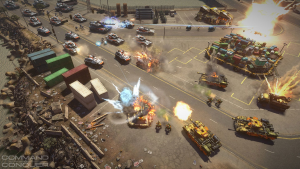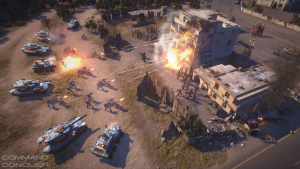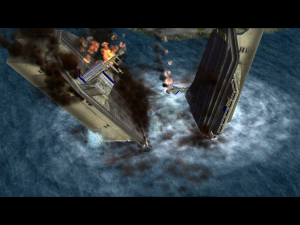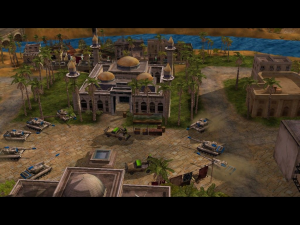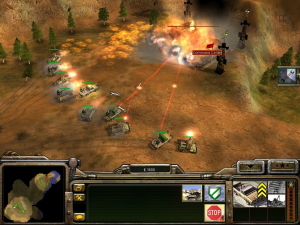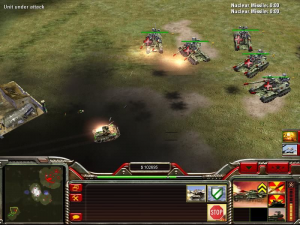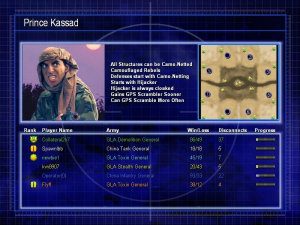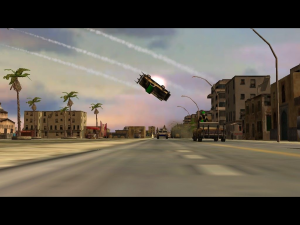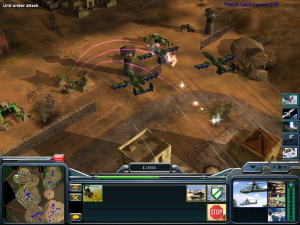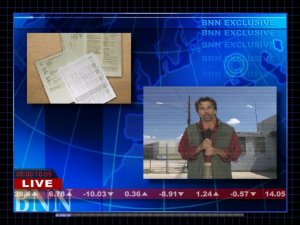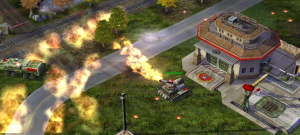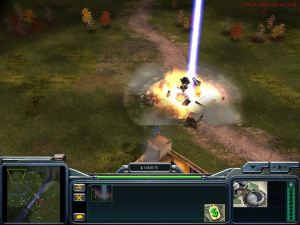- Command and Conquer
- Command and Conquer: Red Alert
- Command and Conquer: Tiberian Sun
- Command and Conquer: Renegade
- Command and Conquer: Red Alert 2
- Command and Conquer Generals
- Command and Conquer 3: Tiberium Wars
- Command and Conquer: Red Alert 3
- Command and Conquer 4: Tiberian Twilight
- Command & Conquer: Generals: Combat Cards
- Command & Conquer 3: Tiberium Wars (Mobile)
- Command & Conquer: Red Alert Mobile
- Command & Conquer: Red Alert (iOS)
- Command & Conquer 4: Tiberian Twilight (Mobile)
- Command & Conquer: Tiberium Alliances
- Red Alert OL
Command and Conquer is considered to be among the definitive franchises of the real time strategy genre. From its origins in 1995 it boasts multiple sequels, spin-offs and a loyal fanbase that persists to this day. The series has also come to be known for many things over the years, including the recurring use of FMV cutscenes, military themes, campy presentation (in the case of the Red Alert games) and RTS conventions still used to this day. By January 2003 however, Westwood Studios, which had until then been responsible for the series had been closed down by EA. Several of its developers and staff went on to found indie company Petroglyph Games (Star Wars: Empire at War, Grey Goo, 8-Bit Armies) later that year. Other former employees meanwhile, particularly from Westwood’s LA branch, were brought under the then-newly reorganized EA Los Angeles. Thus the next entry in the franchise, which had already been in development following Red Alert 2: Yuri’s Revenge, would be finished and released under what was in effect new management.
That game was Command and Conquer: Generals. It took the series firmly into 3D while bringing in various additions and changes to the established RTS formula. When it came out in 2003, it garnered a mostly positive reception from reviewers. But it also gained notoriety, being banned in China due to the perceived heavy-handed depiction of the Chinese faction as well as certain events shown in the campaign, such as a nuclear terror attack at Tiananmen Square right from the onset. Around the same time, it was placed under Germany’s “List of Media Harmful to Young People” for to how it purportedly glorified war and allowed the killing of civilians; this prompted EA to release a heavily edited version akin to the infamous Probotector rendition of Contra. The controversy didn’t end with the censors, not when the game itself had a mixed response from the fandom, to put lightly. A recurring comment at the time was some variation of the same refrain: that it’s Command and Conquer in name only, if not outright underserving of the title. Even those who disagreed generally acknowledged that it’s in some respects a major departure from earlier entries, most notably including its doing away with the FMV cutscenes. Combined with the backlash involving the “ripped from the headlines” overtones, given the then-recent zeitgeist of 9/11, it’s unsurprising then how it soon came to be seen as something of a black sheep in the distinguished franchise.
Over time however, Generals proved itself to be remarkably resilient. Not only does it have both a stable online community and multiplayer scene, but to this day continues to receive support through myriad fanmade mods. It’s also come to be seen by the fandom at large as a solid entry in its own right, much of its gameplay influencing later works in the series for good and ill. But it raises some questions: just why did Generals remain popular even as the future of the Command and Conquer franchise itself remains in limbo?
The most immediate change in Command and Conquer Generals is the graphics. Utilizing SAGE – an engine originally developed by Westwood and further refined by EALA – the game not only brings the franchise officially into 3D, but also tries hard in giving a good impression, and it shows. Buildings, units and vehicles alike show considerable amounts of textures and detail on them, down to the wear-and-tear. In addition, there’s a solid sense of weight and physicality to everything on screen, which isn’t entirely cosmetic either; SAGE allows for environmental effects going beyond trees falling or catching fire, like towers crashing on top of, and even destroying nearby structures and units. Combined with dynamic lighting and copious visual effects, it’s a significant leap from the sprite-laden battlefields of Red Alert 2. In a time when 3D’s become the RTS norm, it’s also helped in making Generals stand out from the crowd; while dated now and with the somewhat blocky models betraying the game’s age, at its highest settings the visuals can still manage to impress over a decade on.
Another distinctive aspect is the premise. In a break from other entries in the series – set in either the serious Tiberian timeline or the campier, alternate history of Red Alert – the game takes place in a near-future universe not unlike our own, more specifically involving a War on Terror gone wrong. Three distinct factions find themselves in midst of a conflict spanning Asia and the Middle East, each with their own campaign: the powerful United States, the nominally allied People’s Republic of China and an insidious terrorist organization known as the Global Liberation Army. The actual campaigns meanwhile (told through generally bombastic in-game cutscenes and loading screen briefings) try to convey a gritty, bombastic storyline reminiscent of a John Ringo book or Tom Clancy movie, albeit without the FMV interludes the franchise is known for. The result isn’t entirely successful, as the storyline comes across as relatively vague and not fully fleshed-out. There isn’t much in the way of memorable characters akin to Kane or Yuri to be found either, which may dampen immersion into the plot. Nonetheless, it does well in capturing the zeitgeist of the immediate post-9/11 aftermath while managing to stand on its own; that it unintentionally anticipates more contemporary current issues like the emergence of the Islamic State/ISIS, the growing use of drones and a more aggressive China on the world stage also lends much to the setting’s poignancy.
What it lacks in lore and the established universes of earlier games, Generals more than makes up for in atmosphere, which also take much inspiration from earlier entries. Even with the generally faux-conventional and muted angle the game has with units and weaponry (many of which are based on existing, modern-day designs near-future prototypes), there are more than a few nods to familiar series staples; the Chinese Gatling Tank for instance not only references a similar unit from Yuri’s Revenge but even uses the same sound effects whenever its gun spins up, while the US Particle Cannon superweapon essentially GDI’s Ion Cannon with a controllable beam. Combined with the art direction and audio, it does a good job in giving all the factions character: whether it’s the buildings’ architecture or the properly-accented if exaggerated voice acting, it’s easy to tell apart the high-tech, gung-ho US from the industrial, nationalistic Chinese and the fervent if hypocritically conniving GLA. In fact, and unlike most other C&C games, this also extends to the unique soundtrack suites, which manage to combine each side’s respective cultural aspects with metal and orchestral setpieces.
Those differences go even further when it comes to the gameplay itself, which is at once unlike and very similar to its predecessors. Unlike previous entries, and due in part to the transition to 3D, from a glance Generals seems to more resemble a Blizzard or Ensemble Studios production than Westwood. There are builder units this time around that are needed for building structures with minimal limitations on the map in the case of the GLA worker, also doubling as gatherers) and faction-specific upgrades, while static supply depots and caches replace the Tiberium/ore fields of earlier works; there’s even an option to either use the more conventional right-click controls found in other RTS.
Looks though, can be deceiving. Building up on Red Alert 2’s diverse selections, the game not only has each faction have an almost entirely unique, if equivalent set of buildings and units, but also has each of them play to their respective specialties. For instance, the GLA’s emphasis on hit-and-run tactics and generally “dirty” warfare is reflected in the ability to set up decoy buildings and a scavenging mechanic that provides extra resources and even jury-rigged upgrades for certain units. Meanwhile, the Americans’ penchant for precision and technological superiority is shown through myriad, albeit expensive air units and vehicles with lasers capable of intercepting enemy missiles. Like in earlier installments, there’s no unit cap, with the number of combatants on the battlefield at any given time limited only by the resources (and PC power) on hand. There’s also enough in the way of balancing and flexibility that the game still provides room for experimentation and all sorts of RTS antics (including the classic tank rush) even while encouraging the chosen side’s strengths. All these, in addition to the environmental effects provided by SAGE, complement the infantry-crushing tank dynamic, garrisonable buildings (though unlike before, there are ways to clear out fortified positions without damaging them) and generally fast-paced action associated with C&C, while providing a fresh coat of paint.
This isn’t getting however to what’s arguably the most significant element that makes Generals stand out: the “Generals” system itself. Taking a few cues from RPGs, there’s experience over a match is gained through killing enemy units. Once said experience points reach a threshold, the player gets “promoted” up a rank, which in turn opens up bonuses, new units and a whole assortment of branching abilities. The more promotions up the chain of command, the more options become available, each one potentially game-changing when played at just the right moment though still not so overpowered that there’s no way of countering them. Those unlockables and powers (both passive and offensive) are also by and large faction-specific, ranging from insta-infantry ambushes for the GLA to stackable artillery barrages for the Chinese to American MOABs that can wipe out a sizable chunk of the map. This opens up a variety of strategies, requiring one to really consider which path of abilities or which unlockable unit to access. By that same token though, it means that even multiplayer rounds have an added layer of unpredictability and tension as battles can turn in the blink of an eye; in other words, no single match plays exactly the same. Even to this day, relatively few RTS games have really copied this system successfully.
Sufficed to say though, Generals isn’t perfect. In addition to the issues brought up, pathfinding can be somewhat finicky, as units don’t always follow the most optimal route from A to B. The AI, while capable of providing a challenge at its higher settings, can be easily exploited, which in turn can limit the game’s single player longevity and leave players unprepared for the much more fluid multiplayer. While the dated graphics can still tax older PCs, especially when there are enough units, explosions and general activity happening all at once.
All the same, combined with recordable replays and a fairly flexible world builder, this entry in the C&C series stands firmly on its own right as a solid game. Something that even those who had qualms with the changes to the formula have generally come to recognize. This isn’t the end of the story though.
Command and Conquer Generals: Zero Hour
With the game’s success, it didn’t take long for an expansion pack to be released. In 2004, it was released as Command and Conquer Generals: Zero Hour. Compared to previous C&C expansions, however, including the well-received Yuri’s Revenge, this one would go even further in terms of additional content while simultaneously making an effort to improve on what’s already there. Those expectations proved to be well founded.
A significant addition is the introduction of nine new sub-factions, three for each side. Represented by generals with unique personalities and expertise, these sub-factions have their own specialties, strengths and weaknesses compared to their baseline counterparts. These are most evident in the unique units, upgrades, abilities and enhancements each one has, but also in many cases in what they don’t have access to. The American Air Force General for instance lacks in substantial ground units but more than makes up in powerful aircraft and aerial support abilities, while the GLA Stealth General can very easily hide from enemies and stage elaborate ambushes but has fewer options for direct assaults; notably, China’s Nuclear General has a full arsenal enhanced with atomic-based technology in some form, albeit at the cost of being more volatile and thus riskier to use. All in all they provide a whole new set of possibilities to explore and exploit in gameplay.
These sub-factions are also related to the new “Generals Challenge” mode for single-player, a first for the franchise. As the name suggests, has the player’s chosen general taking on the others in difficult one-on-one matches over maps reflecting who the enemy is any given round, culminating in a “final boss” commander. It’s here that the personalities of the generals really get their time in the sun, which can be seen in their distinct strategies and attacks against the player (in turn showcasing what their respective sub-factions are capable of). Most notably though, harkening back to the in-game antics of Red Alert 2’s campaigns, each general’s more than willing to talk to, taunt and insult the player, helped along by well done if hammy voice-acting that not only makes each one have their own character (like the sadistic yet deranged “Dr. Thrax” or the no-nonsense US Gen. Townes) but also anticipates winning or losing moves. At the same time, the mode also highlights an additional, albeit loose “rock paper scissors” meta-dynamic with each sub-faction, as certain specializations act as counters of sorts to others though not to the degree of making some matches impossible to win; a general focusing on tanks will have a hard time against one with a knack for aircraft, but can still beat the odds if the cards are played right. The result is a solidly challenging yet entertaining romp that doubles as a sort of meta-tutorial in making the most out of what’s on hand, which is more than useful in multiplayer.
This isn’t to say that Zero Hour improved on everything, which is most evident in the actual single-player campaign. Continuing from where Generals left off, it’s filled with tight, blockbuster-style spectacle as the near-future war against the GLA rages on. Notably it brings back FMVs to a limited extent, with loading screens showing hammily acted news broadcasts that are somewhat related to the levels following them. The missions themselves amp up both the difficulty and scale of the conflict, complete with set-piece cutscenes like a beam from a captured Particle Cannon ripping through an American aircraft carrier. Such antics however don’t quite compensate for how it’s more of the same and doesn’t get the same sort attention seen in Generals Challenge. It doesn’t help either how even compared to the original, the plot stretches willing suspension of disbelief to the point of making the storyline seem like a shallow afterthought, with the GLA’s invasion of Europe being the tip of the iceberg. While not particularly bad as to ruin the experience, it’s evidently not the game’s strongest suit.
In addition, though the game itself is very much complete, there’s much that’s left out. Cut content, including unused audio lines, missing units and unfinished maps abound when one looks through the game’s files, some of which seem almost ready yet never implemented. This is especially telling in Generals Challenge as a handful of generals don’t have their own levels, not to mention how there were supposed to be two more “final bosses” representing the other factions. It gives the impression of a larger work that, perhaps due to time constraints, had to be trimmed substantially.
Still, the content that is already present more than makes up for Zero Hour’s shortcomings. Combined with general refinements in performance and AI, and the result is a very solid package that is to the original Generals what Yuri’s Revenge is to Red Alert 2. This would prove to be a major factor in both bolstering the franchise’s popularity and introducing newcomers to the long-running RTS series.
Zero Hour’s solid showing would inspire EA to greenlight continuations for both the Tiberium and Red Alert universes, just as it helped influence other developers to create games inspired by it, such as Eugen Systems’ Act of War. It won’t be until several years later though when C&C finally returned to the world of Generals. By then however, the situation had changed drastically, and it would never see the light of day.
Cancelled Games; Command and Conquer Generals 2/C&C 2013
In 2011, the then-newly established Victory Games (a studio under the BioWare name, which included former EALA staff) announced the development of Command and Conquer Generals 2. Though it would undergo considerable changes over the next two years (its title alone ultimately becoming just simply Command and Conquer), the game’s continuity with the Generals universe remained a constant.
Set in the wake of a terrorist attack over decade after the events of Zero Hour, it would have featured the technologically advanced European Union in place of America, the China-led Asian Pacific Alliance and a resurgent, more “global” GLA. Each faction, designed to be even more distinct than in the original game, would also have included several generals, all with their own personalities, specializations and exclusive units. The game also dropped the aging SAGE engine in favor of utilizing Frostbite, the same technology used in DICE’s Battlefield series. This in turn would have allowed for not just substantially better graphics and visual effects but also greater realism than was previously possible. Even more significant than that, perhaps, would be how it’s promoted as being a return to form of sorts for the series, featuring an updated version of the same gameplay seeing in the original Generals.
It seemed at first like EA was aiming for this to be a hit Triple-A title. Various circumstances however conspired to ensure that Generals 2 would have the chance to prove itself. In addition to renaming the title, it’s announced in 2012 that the RTS would be a constantly evolving, free-to-play/F2P “client-based game.” This also entailed initially scrapping single-player content in favor of an entirely multiplayer product, which due to significant backlash forced the developers to insist that an actual campaign mode was in the works. A closed alpha version of the game was made available in Gamescom 2013 for testing. On October 25, further updates and a closed beta were promised for later that year, preceding the planned launch in 2014. But on October 29, Victory Games closed its doors and with that, EA pulled the plug. Although the official press release at the time stated that the cancellation was due to negative community feedback in relation to the closed alpha, according to CNC.NZ and PCInvasion, a former employee spoke out in the official forums how contrary to the PR, what doomed the game wasn’t the feedback but “petty corporate politics and shenanigans” attributed to EA. This isn’t to discount how fans were particularly torn over the game’s development, to say the least. Many resented the attempted removal of single-player as well as the F2P aspects, with “pay to win” accusations emerging during the closed alpha when it came to light that EA was in the process of introducing a “Premium” service.
In addition, whatever fanfare the game-in-progress had was at best muted as the series itself was on the rocks. Although more recent outings like Red Alert 3 had become more divisive among the fanbase, it was 2010’s C&C 4: Tiberian Twilight, intended to be the final chapter for the Tiberium universe, that proved to be nigh unanimously reviled, thanks to the questionable changes made to the classic formula (like the removal of base building) and generally poor reviews. With memories of what some called an ignoble “franchise killer” still fresh, not to mention during a time when MOBAs were gaining popularity over more traditional RTS games, Generals 2’s shaky production did little to inspire much confidence among fans. Instead, what players were left with was a stillborn disappointment. Whether or not the game would have actually succeeded in spite of the “shenanigans” is moot at this point.
Thus the planned sequel, meant to revitalize the franchise, marked an ironic low point in its history: if the original Generals heralded a new era for C&C, then Generals 2 seemed to signal the end of that era. Aside from the F2P browser-based Tiberium Alliances still being active at the time of this posting, the odds of an official sequel or reboot in the immediate future remain up in the air.
Though that hasn’t stopped fans from taking matters into their own hands. Which goes back to the original Command and Conquer Generals.
Mod Spotlight: Rise of the Reds
In lieu of official support, Command and Conquer fans have gone the extra mile in carrying on the franchise’s legacy. For Generals, Zero Hour in particular, this has manifested in the form of not just replacement online servers for multiplayer but also game mods that continue to come out long after the original release. Several have since come out for what’s by this point an old game. And while varying in quality, more than a few gems can be found from the lot, even rivaling professional works. Rise of the Reds is one such gem.
Currently under SWR Productions, RoTR is one of the older ones made for Zero Hour, having been around in one form or another since 2004. But while it’s still technically a work in progress (the latest being Version 1.86 at the time of this post, with 1.87 in development), it’s managed to develop its own identity while still retaining the spirit of the original in more ways than one. In the process it’s also become of the most developed and playable mods out there.
Among of the more notable aspects of the mod are the two new sides introduced into the Generals universe: the Russian Federation and the European Continental Alliance. Like the established “canon” factions, each one has their own distinct aesthetics, units, strengths, and for the most part even their own voice acting. The ECA for instance is heavy on defense and relies on advanced technology to an even greater extent than the USA while Russia specializes in full-frontal assaults and conventional warfare, though isn’t afraid to indulge in more experimental weapons. It helps as well that they also hearken to other C&C games while remaining consistent to the setting, such as ECA engineers functioning similarly to their Tiberium and Red Alert counterparts or experimental Tesla tech and Soviet-era reserves being unlockable General powers for the Russians. Arguably more impressive isn’t just how the new factions are fully playable, but also how relatively seamless their inclusion is in terms of gameplay. Some balancing issues notwithstanding, even at this stage they’re shown to be fairly competitive in their own right, introducing both new tactics and interesting spins on existing ones.
Another significant element is the world building. At a glance, one would be forgiven for thinking that the modders put more thought put into the storyline than the actual developers, as RoTR is intended to serve as a fan sequel to the official canon. Not only was a fairly substantial amount of lore for the expanded timeline created (taking place about 20 years after the events of Zero Hour, during World War III) but even expounded upon and in some cases retconned elements of the plot, which include justifying events like the GLA’s “invasion” of Europe. The changes and expansions made to the lore are also reflected in-game, with the new factions as well as existing ones through revamped designs and new units reflecting the time skip and new lore. These are especially evident in the more peculiar protocols available to the ECA, the Chinese largely trading missiles for seemingly obsolete flak weapons or America’s much larger reliance on drones, specialized infantry and aircraft. The end result is a considerably more developed, immersive world that manages to incorporate more classic C&C elements while keeping true in spirit to what makes the Generals universe distinct.
Combined with further graphical tweaks that help update the visuals and generally improved AI, it’s little wonder why the mod continues to be among the highest rated and most popular ones featured on ModDB. But to be sure, RoTR is but one example. Other prominent mods of similar caliber include MidEast Crisis (a total conversion that turns the game into a more realistic depiction of modern warfare in the Middle East), Contra (which takes the various subfactions’ diversity to their logical conclusion) and Untitled (known for pushing the SAGE engine to its limits). For all the variety on display though (more often than having to make do with limited resources and substantial amounts of time), what all these have in common isn’t just how far modders will go. But also, how they demonstrate the staying power Generals has.
In a time when more traditional RTS games aren’t quite as prominent as they once were, when they face stiffer competition from either MOBAs such as League of Legends or the likes of Starcraft 2, a game like Command and Conquer Generals is at once a time capsule for a different era that may not come again, and a competitive, entertaining experience as fresh now as it was over 13 years ago. A reminder of the kind of depth, fun and potential the “old school” can still bring to the table.
When putting all of the above into account, it becomes easier to see why Generals has gained more respect among C&C fans, even with all the deviations from its predecessors. Contrary to old perceptions of it being a black sheep in the family, one could argue that the game hold its own alongside Westwood classics like Red Alert 2. And while it may not surpass the old developers’ works, for all the continuing debates over which C&C is better, it’s nonetheless helped considerably in ensuring the franchise’s continued popularity among gamers.
Whether or not the series can rise back from limbo, at least for the foreseeable future there’s more than enough to satisfy that old urge to command and conquer.
